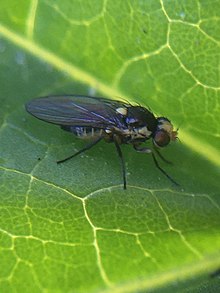
Helicoverpa zea, commonly known as the corn earworm, is a species in the family Noctuidae. The larva of the moth Helicoverpa zea is a major agricultural pest. Since it is polyphagous during the larval stage, the species has been given many different common names, including the cotton bollworm and the tomato fruitworm. It also consumes a wide variety of other crops.
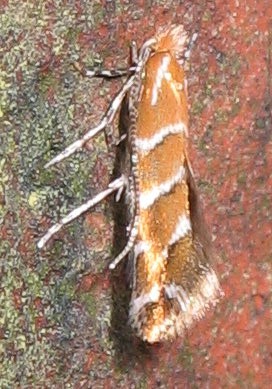
The horse-chestnut leaf miner is a leaf-mining moth of the family Gracillariidae. The horse-chestnut leaf miner was first observed in North Macedonia in 1984, and was described as a new species in 1986. Its larvae are leaf miners on the common horse-chestnut. The horse-chestnut leafminer was first collected and inadvertently pressed in herbarium sheets by the botanist Theodor von Heldreich in central Greece in 1879.
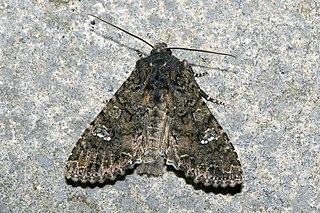
The cabbage moth is primarily known as a pest that is responsible for severe crop damage of a wide variety of plant species. The common name, cabbage moth, is a misnomer as the species feeds on many fruits, vegetables, and crops in the genus Brassica. Other notable host plants include tobacco, sunflower, and tomato, making this pest species particularly economically damaging.

The beet armyworm or small mottled willow moth is one of the best-known agricultural pest insects. It is also known as the asparagus fern caterpillar. It is native to Asia, but has been introduced worldwide and is now found almost anywhere its many host crops are grown. The voracious larvae are the main culprits. In the British Isles, where it is an introduced species and not known to breed, the adult moth is known as the small mottled willow moth.

Phyllophaga is a very large genus of New World scarab beetles in the subfamily Melolonthinae. Common names for this genus and many other related genera in the subfamily Melolonthinae are May beetles, June bugs, and July beetles. They range in size from 12 to 35 mm and are blackish or reddish-brown in colour, without prominent markings, and often rather hairy ventrally. These beetles are nocturnal, and are attracted to artificial lights in great numbers.

A leaf miner is any one of numerous species of insects in which the larval stage lives in, and eats, the leaf tissue of plants. The vast majority of leaf-mining insects are moths (Lepidoptera), sawflies, and flies (Diptera). Some beetles also exhibit this behavior.

The Agromyzidae are a family of flies, commonly referred to as the leaf-miner flies for the feeding habits of their larvae, most of which are leaf miners on various plants. It includes roughly 2,500 species, they are small, some with wing length of 1 mm. The maximum size is 6.5 mm. Most species are in the range of 2 to 3 mm.
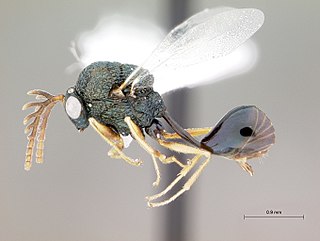
The Eucharitidae are a family of parasitic wasps. Eucharitid wasps are members of the superfamily Chalcidoidea and consist of three subfamilies: Oraseminae, Eucharitinae, and Gollumiellinae. Most of the 55 genera and 417 species of Eucharitidae are members of the subfamilies Oraseminae and Eucharitinae, and are found in tropical regions of the world.

Birch leafminers are sawflies, which are closely related to bees and wasps. They are among the most common insect pests affecting birch trees in North America. The primary species affecting birch trees in North America are Profenusa thomsoni and Fenusa pumila. Areas inside the leaves are consumed by the larvae, affecting the leaves' ability to produce food. Yearly browning of birch leaves are noticed in mid July and August, but the leafminers have been feeding inside the leaf tissue since early spring.

Delia radicum, known variously as the cabbage fly, cabbage root fly, root fly or turnip fly, is a pest of crops. The larvae of the cabbage root fly are sometimes known as the cabbage maggot or root maggot. Delia brassicae was the most common name in literature prior to 1981. The adult flies are about 1 cm long and are grey in colour, but otherwise resemble the common house fly.

Hydrellia pakistanae is a species of fly in the shore fly family, Ephydridae. It is known as the Asian hydrilla leaf-mining fly. It is used as an agent of biological pest control against the noxious aquatic plant hydrilla.
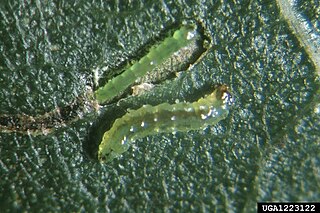
The serpentine leaf miner is the larva of a fly, Liriomyza brassicae, in the family Agromyzidae, the leaf miner flies. It mines wild and cultivated plants, such as cabbage, broccoli, cauliflower and Chinese broccoli.

Pegomya hyoscyami, the beet leafminer or spinach leafminer, is a grey fly about 6 millimetres (0.24 in) long. It emerges in April–May and lays eggs on the undersides of leaves of beet, spinach, chard, and other greens. Eggs develop into larvae that burrow into the leaf hollowing out large patches of the leaf between leaf surfaces, often killing large parts of the leaf.
Delia floralis, commonly known as the turnip root fly or summer cabbage fly, is a cosmopolitan pest of crops. The larvae or maggots feed on the roots of various plants in the family Brassicaceae.

Odontopus calceatus is a species of weevil which occurs in much of the eastern and southeastern United States. Its range is as far north as Massachusetts all the way south to the Gulf of Mexico, and from the Atlantic westward to the Mississippi River. Common names include yellow poplar weevil, sassafras mining weevil, tuliptree leafminer, tulip tree weevil, or the magnolia leaf miner.

Scaptomyza flava is an herbivorous leaf mining fly species in the family Drosophilidae. In Latin, flava means golden or yellow. The fly is amber to dark brown in color and approximately 2.5 mm in length. In Europe and New Zealand the larvae are pests of plants in the order Brassicales, including arugula, brassicas, broccoli, Brussels sprouts, bok choy, cabbage, canola, cauliflower, horseradish, kale, kohlrabi, napa cabbage, nasturtium, radish, rapini, rutabaga, turnip, wasabi and watercress. In New Zealand, its range has expanded to include host species that are intercropped with salad brassicas, including gypsophila, otherwise known as baby's breath, which is in the pink family (Caryophyllaceae) and the pea in the Fabaceae. More typically, S. flava is oligophagous within the Brassicales. Scaptomyza are unusual within the Drospophilidae because the group includes species that are truly herbivorous. Other herbivorous drosophilids include D. suzukii, which attacks fruit very early during ripening and species within the genus Lordiphosa, from Africa and Asia, which also include leaf miners. Most drosophilids feed on microbes associated with decaying vegetation and sap fluxes.
Liriomyza sativae, commonly known as the vegetable leaf miner, is a species of insect, a fly in the family Agromyzidae. The larvae of this fly mine the leaves of a range of vegetables and weeds, but seem to favour plants in the families Cucurbitaceae, Fabaceae and Solanaceae.
Liriomyza trifolii, known generally as the American serpentine leafminer or celery leafminer, is a species of leaf miner fly in the family Agromyzidae.

Profenusa thomsoni, the amber-marked birch leaf miner, is a species of sawfly in the family Tenthredinidae. It is native to the Palearctic realm but has spread to North America. The larvae feed on the foliage of birch trees.
Toxomerus basalis, commonly known as the sundew flower fly, is a species of kleptoparasitic fly endemic to Brazil. It was first described by Francis Walker in 1836. It feeds on captured, immobilized insects caught on the sticky leaves of sundew plants, which are carnivorous. Adult flies seem to have some capacity to escape from Drosera leaves if they have not come into contact with too many of the tentacles. The species is non-specific and have been found on large-leaved, semi-erect, and thread-like Drosera species, such as Drosera graomogolensis and Drosera magnifica.
